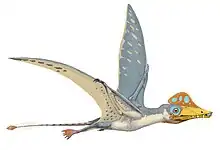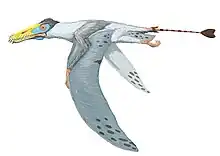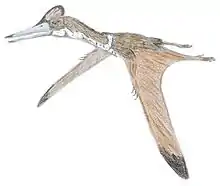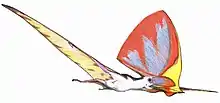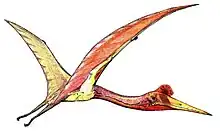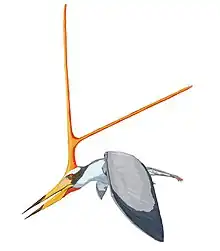| Arthurdactylus Temporal range: | |
|---|---|
| Scientific classification | |
| Domain: | Eukaryota |
| Kingdom: | Animalia |
| Phylum: | Chordata |
| Order: | †Pterosauria |
| Suborder: | †Pterodactyloidea |
| Family: | †Ornithocheiridae |
| Genus: | †Arthurdactylus Frey and Martill 1994 |
| Species: | †A. conandoylei |
| Binomial name | |
| †Arthurdactylus conandoylei Frey, E. & Martill, D.M., 1994 | |
| Synonyms | |
| |
Arthurdactylus is a genus of pterodactyloid pterosaur from the Early Cretaceous Crato Formation of northeastern Brazil. It was a medium-sized pterosaur, with a wingspan of 4.5–4.6 metres (14.8–15.1 ft) and body mass of 15 kg (33 lb).[1][2][3]
In 1994 it was named by Eberhard Frey and David Martill in honor of Arthur Conan Doyle, who featured large reptilian pterosaurs in his novel The Lost World, about a professor finding prehistoric animals still alive on a plateau in South-America. They first spelled the species name as Arthurdactylus conan-doylei, thus with a forbidden diacritic sign, and themselves carried out the necessary emendation to conandoylei in 1998. The holotype is SMNK 1132 PAL, a reasonably complete skeleton, lacking only a skull, neck, sternum and some caudal vertebrae. The specimen, adult or nearly so, was preserved on a plate and is slightly crushed. Arthurdactylus had, compared to the torso length of 22 centimetres, relatively long wings and especially long wing fingers, perhaps much more so than any other pterodactyloid. The hind limbs are however, weakly developed.
The describers assigned Arthurdactylus to the Ornithocheiridae. According to Brazilian paleontologist Alexander Kellner, who uses this concept in a different sense, Arthurdactylus can be best indicated as closely related to the Anhangueridae.
References
- ↑ Frey, E.; Martill, D.M. (1994). "A new Pterosaur from the Crato Formation (Lower Cretaceous, Aptian) of Brazil". Neues Jahrbuch für Geologie und Paläontologie, Abhandlungen. 194 (2–3): 379–412. doi:10.1127/njgpa/194/1994/379.
- ↑ Martill, D.M.; Coram, R.A. "Additional evidence for very large wing-span pterosaurs in the Wessex Formation (Early Cretaceous, Barremian) of southern England" (PDF). Proceedings of the Geologists' Association. 131 (3–4): 293–300. doi:10.1016/j.pgeola.2019.05.002.
- ↑ Paul, Gregory S. (2022). The Princeton Field Guide to Pterosaurs. Princeton University Press. p. 166. doi:10.1515/9780691232218. ISBN 9780691232218. S2CID 249332375.

